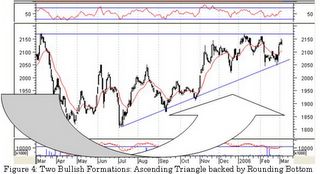``The entrepreneur always searches for change, responds to it, and exploits it as an opportunity."- Peter F. Drucker
The two tables from PricewaterhouseCoopers (
Table 1: Projected real growth in GDP, income per capita and working age population: 2005-50 (%pa)
| Country | GDP in US $ terms | GDP in domestic currency or at PPPs | GDP per capita at PPPs | Working age population |
| | 7.6 | 5.2 | 4.3 | 0.9 |
| | 7.3 | 4.8 | 4.2 | 0.4 |
| | 6.3 | 3.9 | 3.8 | -0.4 |
| | 5.6 | 4.2 | 3.4 | 0.6 |
| | 5.4 | 3.9 | 3.2 | 0.5 |
| | 4.8 | 3.9 | 3.3 | 0.4 |
| | 4.6 | 2.7 | 3.3 | -1.1 |
| | 3.3 | 2.4 | 2.6 | -0.9 |
| | 2.6 | 2.6 | 1.9 | 0.2 |
| | 2.6 | 2.7 | 2.0 | 0.4 |
| US | 2.4 | 2.4 | 1.8 | 0.4 |
| | 2.3 | 2.2 | 2.2 | -0.7 |
| | 1.9 | 2.2 | 2.0 | 0.0 |
| | 1.9 | 2.2 | 2.1 | -0.3 |
| | 1.5 | 1.6 | 1.9 | -0.9 |
| | 1.5 | 1.8 | 1.9 | -0.5 |
| | 1.2 | 1.6 | 1.9 | -0.9 |
Source: PricewaterhouseCoopers LLP GDP growth estimates. Working age population growth from the UN.
Table B: Projected relative size of economies in 2005 and 2050 (US = 100)
| Country (indices with US = 100) | GDP at market exchange rates in US $ terms | GDP in PPP terms | ||
| 2005 | 2050 | 2005 | 2050 | |
| US | 100 | 100 | 100 | 100 |
| | 39 | 23 | 32 | 23 |
| | 23 | 15 | 20 | 15 |
| | 18 | 94 | 76 | 143 |
| | 18 | 15 | 16 | 15 |
| | 17 | 13 | 15 | 13 |
| | 14 | 10 | 14 | 10 |
| | 9 | 8 | 9 | 8 |
| | 8 | 9 | 9 | 9 |
| | 6 | 58 | 30 | 100 |
| | 6 | 8 | 9 | 8 |
| | 6 | 17 | 9 | 17 |
| | 5 | 6 | 5 | 6 |
| | 5 | 20 | 13 | 25 |
| | 5 | 13 | 12 | 14 |
| | 3 | 10 | 5 | 10 |
| | 2 | 19 | 7 | 19 |
Source: PricewaterhouseCoopers LLP estimates (rounded to nearest percentage point)
Of course these are nothing more than assumptions with immense probabilities of deviations from the embedded very long-term forecasts, akin to those institutions or buyers of sovereign 50-year bonds (whom are projecting more of the past and present to the future).
However, the essential point driven by PricewaterhouseCoopers is that the critical sources of the largest growth potentials come from Emerging markets rather developed ones, characterized by the confluence of a large dynamic growing populations, are resource rich and have been capitalizing from the ongoing wealth and technology transfer as the global division of labor gets to be highlighted, on the backdrop of increasing trends of globalization, or economic growth on more trade and financial integration (unless subverted by protectionist policies).
Investors looking for YIELD outperformance should therefore seriously look at or consider the prospects of investing in emerging markets as ours. It is probably one reason why foreign investments constitute a majority of the activities in the Phisix despite the mephitic political atmosphere. If the


